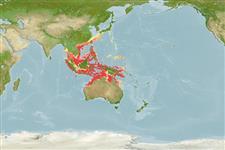Classification / Names
Common names from other countries
Main reference
Size / Weight / Age
Max length : 35.0 cm SL male/unsexed; (Ref. 4787)
Environment
Marine; demersal; non-migratory; depth range 40 - 235 m (Ref. 5222)
Climate / Range
Tropical, preferred ?; 35°N - 20°S, 94°E - 155°E (Ref. 5222)
Distribution
Short description
Dorsal
spines
(total): 11;
Dorsal
soft rays
(total): 14-15;
Anal
spines: 3;
Anal
soft rays: 8. Distinguished by the following characteristics: body depth contained 2.7-3.2 times in SL; HL 2.2-2.4 times in SL; slightly convex interorbital area, distinctly convex dorsal head profile; preopercle angular, with 2-4 large spines at the angle; upper edge of operculum approximately straight; posterior nostril about twice as large as anterior nostril; maxilla usually reaches to or slightly past a vertical at rear edge of eye; step-like extension on lower edge of maxilla in adults; well developed canines at from of jaws, especially in upper jaw; 2 rows of teeth on midlateral part of lower jaw; pyloric caeca 7 or 8 (Ref. 89707).
IUCN Red List Status (Ref. 115185)
Threat to humans
Harmless
Human uses
Fisheries: commercial
More information
ReferencesAquacultureAquaculture profileStrainsGeneticsAllele frequenciesHeritabilityDiseasesProcessingMass conversion
Tools
Special reports
Download XML
Internet sources
Estimates of some properties based on models
Phylogenetic diversity index
PD50 = 0.5000 many relatives (e.g. carps) 0.5 - 2.0 few relatives (e.g. lungfishes)
Trophic Level
3.8 ±0.6 se; Based on size and trophs of closest relatives
Resilience
Medium, minimum population doubling time 1.4 - 4.4 years (Preliminary K or Fecundity.)
Vulnerability
Moderate vulnerability (45 of 100)
Price category
